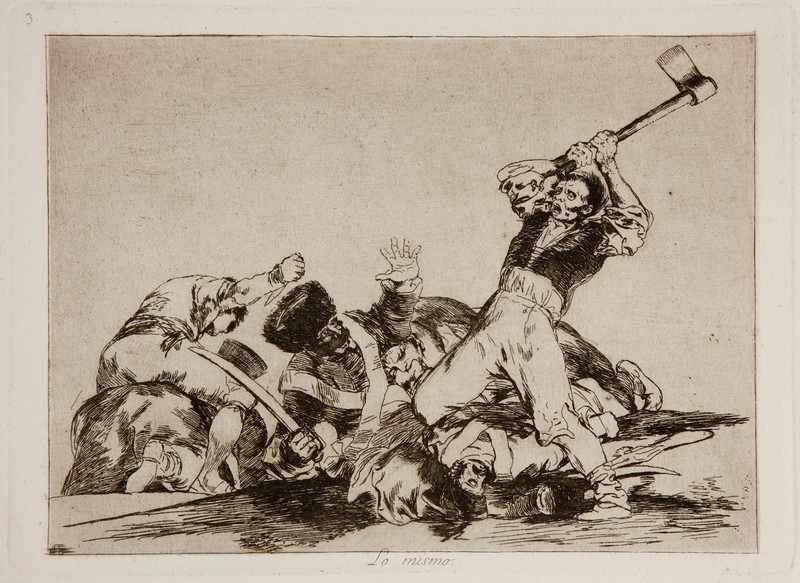- Cronología
- Ca. 1810 - 1815
- Dimensiones
- 162 x 223 mm
- Técnica y soporte
- Etching, aquatint, burin, drypoint and burnisher
- Reconocimiento de la autoría de Goya
- Undisputed work
- Ficha: realización/revisión
- 09 Aug 2012 / 24 May 2023
- Inventario
- 225
48 (lower left-hand corner).
See Sad presentiments of what must come to pass.
There exists a state proof of this print with lavis and burnishing over the lines on the right thigh of the man who is shown raising the axe. There is another state proof which bears the number 48. Later, the number 3 was added, along with some touches of drypoint and burin.
The title was handwritten by Goya on the first and only print run that we know to have been made at the time, and which the painter gave to his friend Agustín Ceán Bermúdez. The title was engraved on to the copperplate at a later date, and no other modifications were made to the image for the first edition of the Disasters of War, which was printed by the Royal Academy of Fine Arts of San Fernando, Madrid, in 1863.
No preparatory drawings for this print have been conserved.
In front of a pale background we see, in the foreground, the silhouette of a man raising an axe in both hands as he opens his mouth to shout. He is a Spaniard, and is about to decapitate the Frenchman lying on the ground before him. Behind these two characters, Goya has depicted a tangle of bodies engaged in a vicious fight with all sorts of different weapons. In one case, a French soldier with a sword fends off the attack of a Spaniard. Further back, a Spaniard who has clambered on to the back of a Frenchman is about to stab him with a knife. The ferocity of the Spaniards has allowed them to overwhelm the better-armed enemy in brutal fashion.
In this print, Goya stays with the theme addressed in print no. 2, With or without reason, and traces between the two works an analogous relationship which serves to demonstrate that these two scenes are in fact two sides of the same coin: violence. The Aragonese artist finds both acts unjustifiable and refuses to take the side of either the Spanish or the French.
A comparison suggests itself between the face of the figure holding the axe and those paintings in which Goya represents scenes of cannibalism. The wild round eyes, the lost expression, the emaciated face and marked cheekbones, and the gaping mouth all lend this character a primitive air and make him look like a relative to some tribe of cannibals. Goya uses these facial features to refer to the irrationality of these acts, both those of the Spaniard killing a French soldier and those of the cannibals tearing apart their human victims. Furthermore, the posture adopted by the man with the axe bears a strong resemblance to that of the figure who is shown with his back to the viewer in The Forge, of which a preparatory drawing has also been conserved.
This print also suggests some clear parallels with a print by Hanns Ulrich Franckh (1590/1595, Kaufbeuren-1675, Augsburg) that shows a man wielding an axe and preparing to attack a second figure lying on the ground (1656, Hamburger Kunsthalle). In this case, the analogies are not limited to the subject matter but also extend to the wild, hate-filled expression on the face of the figure wielding the axe.
The etching plate is conserved in the National Chalcography Museum (cat. 254)
-
De grafiek van GoyaRijksmuseum RijksprentenkabinetAmsterdam1970from November 13th 1970 to January 17th 1971cat. 57
-
Goya y el espíritu de la IlustraciónMuseo Nacional del PradoMadrid1988from October 6th to December 18th 1988. Exhibited also at Museum of Fine Arts, Boston, January 18th to March 26th 1989; The Metropolitan Museum of Art, Nueva York, May 9th to July 16th 1989, Madrid curator Manuela B. Mena Marqués, scientific directors Alfonso E. Pérez Sánchez and Eleanor A. Sayrecat. 82
-
Francisco de GoyaMuseo d'Arte ModernaLugano1996exhibition celebrated from September 22nd to November 17th.cat. 108
-
Francisco Goya. Sein leben im spiegel der graphik. Fuendetodos 1746-1828 Bordeaux. 1746-1996Galerie KornfeldBern1996from November 21st 1996 to January 1997cat. 92
-
Das Capriccio als KunstprinzipWallraf-Richartz-Museum,1996from December 8th 1996 to February 16th 1997, exhibited also in Zurich, Kunsthaus, from March 14th marzo 1997 to June 1st 1997 and in Vienna, Kunsthistorisches Museum mi Palais Harrach, from June 29th 1997 to September 21st 1997.cat. 108
-
Francisco Goya. Capricci, follie e disastri della guerraSan Donato Milanese2000Opere grafiche della Fondazione Antonio Mazzottacat. 82
-
Goya. Opera graficaPinacoteca del Castello di San GiorgioLegnano2006exhibition celebrated from December 16th 2006 to April 1st 2007p. 52
-
Goya en tiempos de guerraMuseo Nacional del PradoMadrid2008consultant editor Manuela B. Mena Marqués, from April 14th to July 13th 2008cat. 82
-
Goya et la modernitéPinacothèque de ParisParís2013from October 11st 2013 to March 16th 2014cat.42
-
Goya, grabadorMadridBlass S.A.1918cat. 105
-
Goya engravings and lithographs, vol. I y II.OxfordBruno Cassirer1964cat. 996
-
Vie et ouvre de Francisco de GoyaParísOffice du livre1970cat. 123
-
Goya y el espíritu de la IlustraciónMadridMuseo del Prado1988p.289-290, cat. 82
-
Catálogo de las estampas de Goya en la Biblioteca NacionalMadridMinisterio de Educación y Cultura, Biblioteca Nacional1996cat. 185
-
Goya. Los desastres de la guerra, lBarcelonaLa Central2011p. 22
-
ParísPinacoteca de París2013p. 121
-
Goya. In the Norton Simon MuseumPasadenaNorton Simon Museum2016pp. 114-151
